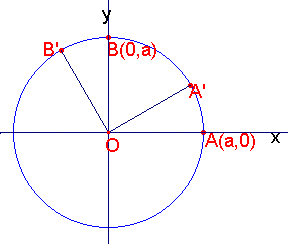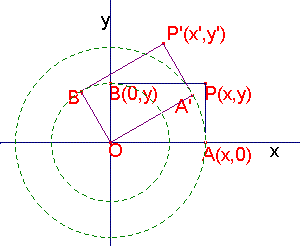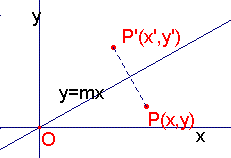回転変換と対称変換
第2部は平面の変換を,特に回転変換,相似変換,回転相似変換を中心に初等幾何的取り扱いをします.
前半は異なる点の周りの回転変換,相似変換,回転相似変換の合成がどうなるかを調べ,
後半では,変換を利用して問題を解いていきます.
解答を見ながら,
変換の重要性が感じ取ってもらえるのではないかと思います.
まず現在高校ではどのように回転変換,
対称変換を扱っているかを復習します.
平面の変換を系統だって学ぶのは,ある時は行列を用い,ある時は複素数を用い教育課程の変更でしばしば変わります.
どちらも優れた点があるのは分かりますが,教員間では評判が悪い.教員も勉強しろということなのでしょう.
 行列での取り扱いからはじめましょう.
行列での取り扱いからはじめましょう.
点$A(a,0)$を原点の周りに$\theta$だけ回転した点$A'$は
$A'(a\cos \theta ,a\sin \theta )$
で,$B(0,a)$を原点の周りに$\theta$だけ回転した点$B'$は
$\cos (\theta +\frac{\pi}{2})=-\sin \theta,$
$\sin (\theta +\frac{\pi}{2})=\cos \theta$
であるから
$B'(-a\sin \theta,a\cos \theta)$
である.
点$P(x,y)$を原点の周りに$\theta$だけ回転した点$P'(x',y')$
を求めよう.
点$P$だけでなく,点$P$を$x$軸,$y$軸に下した垂線の足をそれぞれ$A,B$として,
長方形$OAPB$を原点の周りに回転する.
 右図で,
右図で,
$A'(x\cos \theta ,x\sin \theta)$
$B'(-y\sin \theta ,y\cos \theta)$
であるから
$\overrightarrow{OP'}=\overrightarrow{OA'}+\overrightarrow{OB'}$
$=(x\cos \theta -y\sin \theta,x\sin \theta+y\cos \theta)$
したがって,
$P(x,y)$を原点の周りに$\theta$だけ回転した点を$P'(x',y')$とすると,
$\begin{pmatrix}x'\\y'\end{pmatrix}
=\begin{pmatrix}x\cos \theta
-y\sin \theta\\x\sin \theta+y\cos \theta\end{pmatrix}$
$=\begin{pmatrix}\cos \theta & -\sin \theta\\\sin \theta &\cos \theta
\end{pmatrix}\begin{pmatrix}x\\y\end{pmatrix}$
と行列表示される.
 つぎに原点を通る直線に関する対称変換を求めよう.
つぎに原点を通る直線に関する対称変換を求めよう.
直線$y=mx$に関して$P(x,y)$と$P'(x',y')$が対称のとき
$\overrightarrow{PP'}\cdot (1,m)=0$
および,2点$P,P'$の中点が直線$y=mx$上より
$\begin{cases}
(x'-x,y'-y)\cdot (1,m)=0\\
\dfrac{y'+y}{2}=m\dfrac{x+x'}{2}\end{cases}\cdots (\sharp)$
$x',y'$を$x,y$について解くと
$x'=\dfrac{(1-m^2)x+2my}{1+m^2}$
$y'=\dfrac{2mx-(1-m^2)y}{1+m^2}$
ここで直線$y=mx$と$x$軸のなす角を$\theta$すなわち
$m=\tan \theta$
のとき
$\cos 2\theta =\dfrac{\cos 2\theta}{\cos ^2\theta+\sin ^2\theta}$
$=\dfrac{\cos ^2\theta-\sin ^2\theta}{\cos ^2\theta+\sin ^2\theta}
=\dfrac{1-\tan ^2\theta}{1+\tan^2\theta}=\dfrac{1-m^2}{1+m^2}$
$\sin 2\theta =\dfrac{\sin 2\theta}{\cos ^2\theta+\sin ^2\theta}$
$=\dfrac{2\sin \theta \cos ^2\theta}{\cos ^2\theta+\sin ^2\theta}
=\dfrac{2\tan \theta}{1+\tan^2\theta}=\dfrac{2m}{1+m^2}$
したがって
$\begin{cases}x'=x\cos 2\theta +y\sin 2\theta \\
y'=x\sin 2\theta -y\cos 2\theta \end{cases}$
行列で表すと
$\begin{pmatrix}x'\\y'\end{pmatrix}
=\begin{pmatrix}\cos 2\theta & \sin 2\theta\\ \sin 2\theta &-\cos 2\theta
\end{pmatrix}\begin{pmatrix}x\\y\end{pmatrix}$
である.
ただ,この方法は上記$(\sharp)$から$x',y'$を$x,y$について解くのが簡単でない.
実際の授業では,対称変換の合成は回転変換であることを用いる,
 次の方法が用いられる.
次の方法が用いられる.
直線$y=mx$に関する対称変換を$f$,$x$軸に関する対称変換を$g$とする.
ここで$m=\tan \theta$のとき
$f\circ g$は原点の周りに$2\theta$回転する回転変換(右図で$a+b=\theta$)
$f=(f\circ g)\circ g:P\mapsto P"\mapsto P'$
とみる.
ここで$x$軸に関する対称変換を表す行列は
$\begin{pmatrix}1&0\\0&-1\end{pmatrix}$
であるから,
直線$y=mx=(\tan \theta)x$に関する対称変換を表す行列は
$\begin{pmatrix}\cos 2\theta&-\sin 2\theta \\ \sin 2\theta&\cos 2\theta\end{pmatrix}
\begin{pmatrix}1&0\\0&-1\end{pmatrix}$
$=\begin{pmatrix}\cos 2\theta & \sin 2\theta\\ \sin 2\theta & -\cos 2\theta \end{pmatrix}$
である.
さて,原点の周りの回転変換も,原点を通る直線に関する対称変換も原点は原点にうつし,2点間の距離を変えない.
逆に,原点を原点にうつし,かつ2点間の距離を変えない線型変換を求めよう.
$f:\begin{pmatrix}x\\y\end{pmatrix}\mapsto \begin{pmatrix}x'\\y'\end{pmatrix},\begin{pmatrix}x'\\y'\end{pmatrix}
=\begin{pmatrix}a&b\\c&d\end{pmatrix}\begin{pmatrix}x\\y\end{pmatrix}$
が2点間の距離を変えないとき,原点との距離も変えないから(必要条件)
任意の$x,y$で
$x^2+y^2=(ax+by)^2+(cx+dy)^2$
すなわち
$x^2+y^2=(a^2+c^2)x^2+2(ab+cd)xy+(b^2+d^2)y^2$
したがって,行列
$\begin{pmatrix}a&b\\c&d\end{pmatrix}$
は
$a^2+c^2=1,b^2+d^2,ab+cd=0$
である.
$a=\cos \theta,c=\sin \theta,b=\cos \phi ,d=\sin \phi$
とおくと,2つのベクトル$\begin{pmatrix}a\\c\end{pmatrix},\begin{pmatrix}b\\d\end{pmatrix}$は直交するから
$\theta =\phi +\dfrac{\pi}{2}$または$\theta =\phi -\dfrac{\pi}{2}$
$\theta =\phi +\dfrac{\pi}{2}$のとき
$\begin{pmatrix}\cos \theta&\cos \phi\\\sin \theta&\sin \phi\end{pmatrix}=
\begin{pmatrix}\cos \theta&-\sin \theta\\\sin \theta&\cos \theta\end{pmatrix}$
これは原点の周りの回転変換.
$\theta =\phi -\dfrac{\pi}{2}$のとき
$\begin{pmatrix}\cos \theta&\cos \phi\\ \sin \theta&\sin \phi\end{pmatrix}=
\begin{pmatrix}\cos \theta&\ \sin \theta\\\sin \theta&-\cos \theta\end{pmatrix}$
これは原点を通る直線に関する対称変換.
以上で,原点を原点にうつす線型変換で距離を保つものは回転変換か対称変換のいずれかであることがわかった.
さてここで,原点を原点にうつす変換を線型変換に限定して議論しているところが気になるところである.すなわち
変換$\mathbb{R}^2\longrightarrow \mathbb{R}^2;x'=f(x,y),y'=g(x,y)$
で$f(x,y),g(x,y)$が定数項を含まない1次式以外に距離を保つ場合があるかどうかである.
この問題については
原点を原点にうつす変換で距離を保つものは線型変換に限る
が知られている.
回転変換,対称変換の行列式を計算すると
$\det \begin{pmatrix}\cos \theta&-\sin \theta\\\sin \theta&\cos \theta\end{pmatrix}=\cos ^2\theta +\sin ^2\theta =1$
$\det \begin{pmatrix}\cos \theta&\ \sin \theta\\\sin \theta&-\cos \theta\end{pmatrix}=-\cos ^2\theta -\sin ^2\theta =-1$
である.
そこで,距離を保つ変換のうち行列式が$1$の方を回転変換,$-1$の方を対称変換とみれば,
命題
$T_1,\dots ,T_n$は原点の周りの回転変換か原点を通る直線に関する対称変換のいずれかである.このときn個の変換の合成
$T_1\circ \cdots \circ T_n$
は,$T_1,\dots ,T_n$のうち,対称変換の個数が偶数個なら回転変換であり,奇数個なら対称変換である
が成り立つことが容易に分かる.
次に原点の周りの回転変換,原点を通る直線に関しての対称変換の複素数での取り扱いを説明します.
$(\cos \alpha +i\sin \alpha)(\cos \beta +i\sin \beta )$
$=\cos (\alpha +\beta)+i\sin (\alpha +\beta)$
が成り立つことより
原点の周りの回転角$\theta$の回転変換は
$z\mapsto (\cos \theta +i\sin \theta)z$
であることが分かる.
$z=x+iy$を代入し
$(\cos \theta +i\sin \theta)(x+iy)$
$=(x\cos \theta -y\sin \theta )+i(x\sin \theta +y\cos \theta)$
したがって,
$(x,y)\mapsto (x\cos \theta -y\sin \theta ,x\sin \theta +y\cos \theta)$
を得る.
次に原点を通る直線に関する対称変換である.
すでに述べたが
 直線$y=mx$に関する対称変換を$f$,$x$軸に関する対称変換を$g$とする.
直線$y=mx$に関する対称変換を$f$,$x$軸に関する対称変換を$g$とする.
ここで$m=\tan \theta$のとき
原点の周りの回転角$2\theta$の回転変換を$h$とすると
$P\stackrel{f}{\mapsto}P'$は
$P\stackrel{g}{\mapsto}P"\stackrel{h}{\mapsto}P'$とみることができる.
$x$軸に関する対称変換は
$z\mapsto \bar{z}$
であるから,$y=(\tan \theta )x$に関する対称変換は
$z\mapsto (\cos 2\theta +i\sin 2\theta )\bar{z}$
である.
$z=x+iy$を代入し
$(\cos 2\theta +i\sin 2\theta)(x-iy)$
$=(x\cos 2\theta +y\sin 2\theta)+i(x\sin 2\theta -y\cos 2\theta)$
すなわち
$(x,y)\mapsto (x\cos 2\theta +y\sin 2\theta ,x\sin 2\theta -y\cos 2\theta)$
を得る.
ここでは2つの対称変換の合成が回転変換になることを用いている.直接計算で求めるなら次のようにすればよい.
複素平面上で,直線$l;y=mx$に関して対称な点を$P_1(z_1),P_2(z_2)$とする.
まず,直線$l$の方程式を求める.
$l$の法線ベクトルを表す複素数を$a$とする.
$l$上の任意の点を$z$とすると$l$は原点を通るから
$z\perp a$
したがって$\frac{z}{a}$は純虚数.したがって
$\dfrac{z}{a}+\dfrac{\bar{z}}{\bar{a}}=0\cdots (\sharp)$
$(\sharp)$が直線$l$の方程式である.
$P_1P_2$は$a$と平行であるから$\frac{z_2-z_1}{a}$は実数.したがって
$\dfrac{z_2-z_1}{a}-\dfrac{\bar{z_2}-\bar{z_1}}{\bar{a}}=0\cdots (1)$
線分$P_1P_2$の中点が直線$l$上より
$\dfrac{z_1+z_2}{2a}+\dfrac{\bar{z_1}+\bar{z_2}}{2\bar{a}}=0\cdots (2)$
$(1)+2\times (2)$より
$\dfrac{z_2}{a}+\dfrac{\bar{z_1}}{\bar{a}}=0$
したがって,
$z_2=-\dfrac{a}{\bar{a}}\bar{z_1}$
ここで,$a=i(1+im)=-m+i,z_1=x+iy$を代入すると
$=\dfrac{(1-m^2)+2mi}{1+m^2}(x-iy)$
$=\dfrac{1-m^2}{1+m^2}x+\dfrac{2m}{1+m^2}y+i\left(\dfrac{2m}{1+m^2}x-\dfrac{1-m^2}{1+m^2}y\right)$
$m=tan \theta$とおくと
$=(x\cos 2\theta +y\sin 2\theta )+i(x\sin 2\theta -y\cos 2\theta)$
したがって,直線$y=(\tan \theta )x$に関する対称変換は
$(x,y)\mapsto (x\cos 2\theta +y\sin 2\theta ,x\sin 2\theta -y\cos 2\theta)$
である.
回転変換
目次
|
 行列での取り扱いからはじめましょう.
行列での取り扱いからはじめましょう. 右図で,
右図で, つぎに原点を通る直線に関する対称変換を求めよう.
つぎに原点を通る直線に関する対称変換を求めよう. 次の方法が用いられる.
次の方法が用いられる.